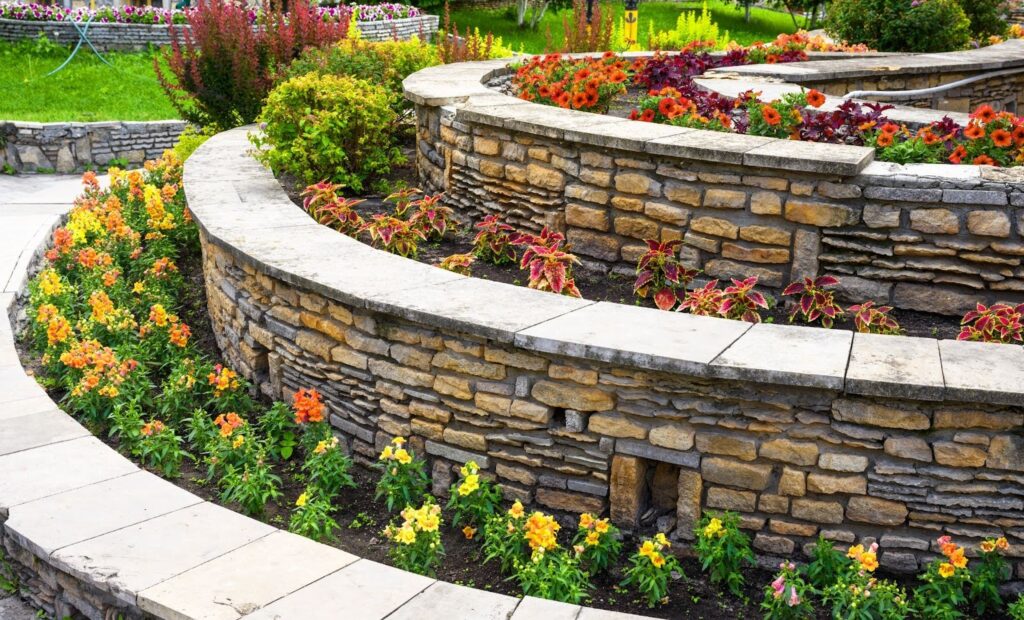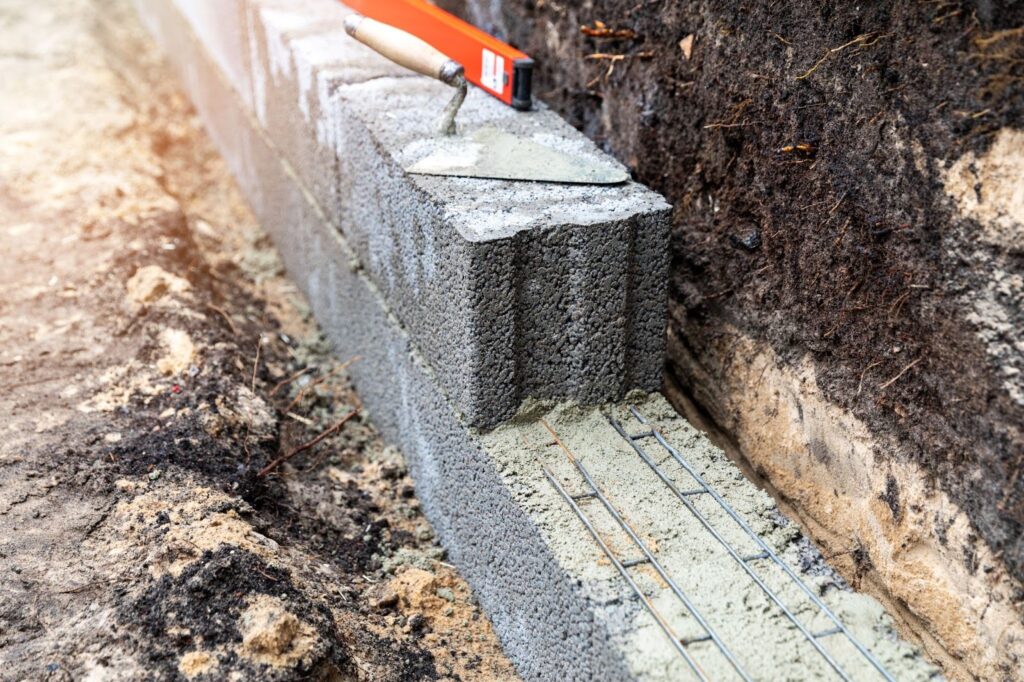Retaining walls are an aesthetic addition to your landscape, providing functionality and beauty. These structures transform and maintain the integrity of your yard and are especially useful in areas with uneven terrain.
Retaining walls prevent erosion and create flat, usable spaces in sloped areas. They help manage water runoff and maintain the health of your landscape.
Whether you’re a homeowner looking to enhance your yard’s functionality and appeal or a landscaping enthusiast, this guide will equip you with everything you need to know about retaining walls.

Understanding retaining walls
Retaining walls are engineered solutions designed to restrain soil to a slope it would not naturally keep. In simpler terms, they turn a slope into a step.
These structures are essential in areas that need extra support to prevent soil erosion, especially landscapes with hilly or uneven terrain. By holding back soil, retaining walls create stable and level spaces for gardens, patios, or play areas.
Several types of retaining walls are suited to different needs and landscapes. Understanding the different types of retaining walls helps you select the right one for your landscape.
Gravity walls
These rely on their mass (stone, concrete, or other heavy material) to resist pressure from behind. They are suitable for shorter slopes.
Cantilevered walls
Cantilevered walls are constructed with a reinforced concrete base and a thin stem. These walls require less material than gravity walls. They use leverage to hold back large amounts of soil.
Sheet piling walls
Sheet piling walls work well in tight spaces or soft soils. Workers make these walls from thin, interlocking sheets of material, typically steel, vinyl, or wood, and drive them into the ground.
Anchored walls
These can be any of the above types but have additional reinforcement from cables or other stays anchored in the rock or soil behind them. They are best for when high loads are expected or when the wall itself needs to be slender and would otherwise be too weak.
Benefits of retaining walls
Retaining walls offer many benefits that extend beyond their visual appeal. They safeguard your landscape while enhancing its functionality and aesthetic value.
Erosion control and slope management
One of the primary benefits of retaining walls is their ability to prevent soil erosion. In areas with sloped terrain, soil can gradually wear away due to wind and water, leading to unstable ground and a shifting landscape.
Retaining walls act as a barrier, holding soil in place and maintaining the integrity of your yard. They are particularly effective in managing water runoff, directing it away from areas where it could cause damage.
Aesthetic appeal and functional space creation
Retaining walls transform uneven and unusable yard areas into attractive, functional spaces. They provide structure to your landscape, allowing for the creation of terraced gardens, leveled play areas, or outdoor living spaces.
Increase in property value
Well-designed and properly installed retaining walls increase the value of your property. They enhance the overall look of your landscape and contribute to its functionality. This investment in your landscape boosts your property’s market value.
Choosing the right retaining wall
Choosing the right retaining wall for your landscape requires carefully considering several factors. It’s not only about picking the most visually appealing option; you want to find a solution that meets the specific needs of your property while adhering to local regulations and ensuring long-term stability and safety.
Factors to consider:
Soil type: The type of soil in your yard plays a crucial role in determining the appropriate type of retaining wall. Different soils have varying drainage levels and weight-bearing capacities. These factors will affect the wall’s stability.
Slope and height: The slope of your land and the desired wall height are critical in selecting the right type. Taller walls or those holding back steeper slopes require stronger materials and more complex construction techniques.
Aesthetics: The retaining wall should complement your home’s architecture and landscape. Consider the visual impact and how the wall will integrate with your overall landscaping design.
Comparison of materials:
Concrete: Known for its strength and durability, concrete is ideal for high-load-bearing walls. It can be molded into various shapes and textures, offering versatility in design.
Stone: Natural stone walls are beautiful and blend well with the environment. They are durable but are usually more expensive and require skilled craftsmanship.
Wood: Wood offers a natural, rustic look and is generally more cost-effective. However, it may not be as durable as stone or concrete and requires maintenance to prevent decay.
Brick: Brick walls provide a classic look and are durable. They require skilled installation and are effective in moderate-load situations.
Professional assessment and local regulations
Consulting with a professional will help you choose the best type of retaining wall for your property. Professionals assess your property’s needs by considering soil type, slope, local codes, and other factors.
Construction of retaining walls
Constructing a retaining wall is a project that requires careful planning and execution. Whether considering a DIY approach or hiring professionals, understanding the basic steps involved is helpful. Here’s a guide to building a basic retaining wall:
Planning and design
Start by determining the location, size, and type of wall you need. Consider the wall’s purpose, the terrain, and the aesthetic you want to achieve.
Gathering materials
Based on your design, gather the necessary materials. Materials include wall blocks or stones, drainage materials like gravel, and tools for construction.
Preparing the foundation
A solid foundation is critical for the stability of your wall. Excavate the area to create a level base. Compact the soil and add a layer of paver base to stabilize the ground.
Laying the first row
The first row of blocks or stones is crucial as it sets the alignment for the rest of the wall. Ensure it’s level and properly aligned. Use a rubber mallet to adjust the blocks as needed.
Building up the wall
Continue adding layers of blocks, ensuring each layer is level and staggered from the one below it for stability. Use landscape adhesive for additional strength.
Ensuring proper drainage
Install drainage behind the wall to prevent water buildup. Lay landscape fabric and fill the space with gravel. Doing this diverts water away from the wall.
Finishing touches
Once the wall reaches the desired height, add a capstone or top layer for a finished look. Secure these top stones with adhesive.
Importance of proper drainage and foundation
Proper drainage prevents water pressure from building behind the wall, which can lead to structural failure. A strong foundation prevents the settling and shifting of the wall.
DIY vs. hiring professionals:
While building a small retaining wall can be a DIY project, call on professionals to construct larger or more complex walls. They have the expertise to handle challenges like unstable soil, large slopes, and compliance with local building codes.

Common challenges and solutions
Retaining walls are vital for managing landscapes. However, they have their challenges. These challenges require prompt and practical solutions to ensure their longevity and stability.
Dealing with soil pressure and drainage issues
Soil pressure often goes up after heavy rainfall. Increased soil pressure exerts force on the wall. Proper drainage mitigates this. When building a retaining wall, incorporate a drainage system behind the wall, using gravel and drainage pipes to channel water away.
For existing walls facing pressure issues, consider installing weep holes to allow trapped water to escape. This reduces pressure on the wall.
Addressing common problems like leaning walls or bulges
Leaning walls or bulges usually indicate foundational issues or inadequate drainage. It may be possible to fix minor leans by adjusting the blocks or stones and reinforcing the base. However, significant leans often require professional assessment and reconstruction.
Regularly inspect your wall for early signs of bulging or leaning. Early detection allows for simpler, more cost-effective repairs.
Maintenance tips for longevity and stability
- Regularly clear debris from the top and base of the wall to prevent water accumulation and ensure unobstructed drainage.
- Inspect the wall for cracks or signs of wear, especially after extreme weather conditions. You can usually fill small cracks, but larger ones may indicate deeper structural issues.
- Vegetation growth on the wall is aesthetically pleasing, but monitor it to ensure roots aren’t causing damage.
- Proactive maintenance and addressing issues early maintain the long-term health of your retaining wall. Regular checks and timely interventions prevent minor problems from becoming major, costly issues.
Innovative ideas for retaining wall landscaping
Retaining walls offer a canvas for creativity, allowing you to enhance your landscape’s functionality and aesthetic appeal. Here are some innovative ideas for integrating retaining walls into your yard:
Tiered garden walls
Create a visually striking tiered garden with multiple levels of retaining walls. Have each tier host different types of plants to add depth and variety to your landscape.
Integrated seating
Build seating into your retaining wall for a practical and stylish feature. This approach is perfect for creating an inviting outdoor living space for relaxation and entertaining guests.
Incorporating water features
Add a dynamic element by integrating water features into your retaining walls. Whether it’s a cascading waterfall over the stones or a built-in fountain, water features bring a sense of tranquility and elegance.
Raised garden beds
Utilize retaining walls to construct raised garden beds. This makes for an attractive garden layout and offers easy access for planting and maintenance.
Come to LaytonScape for all your retaining wall needs
If you’re contemplating adding a retaining wall or need guidance on maintaining an existing one, LaytonScape is here to provide expert advice and tailored solutions. We are your one-stop shop for all your landscaping needs. Our 40 years of experience in landscaping, hardscaping, and design guarantees that we have a solution for you.
Contact LaytonScape today to transform your landscape. Let’s work together to bring your vision to life.



